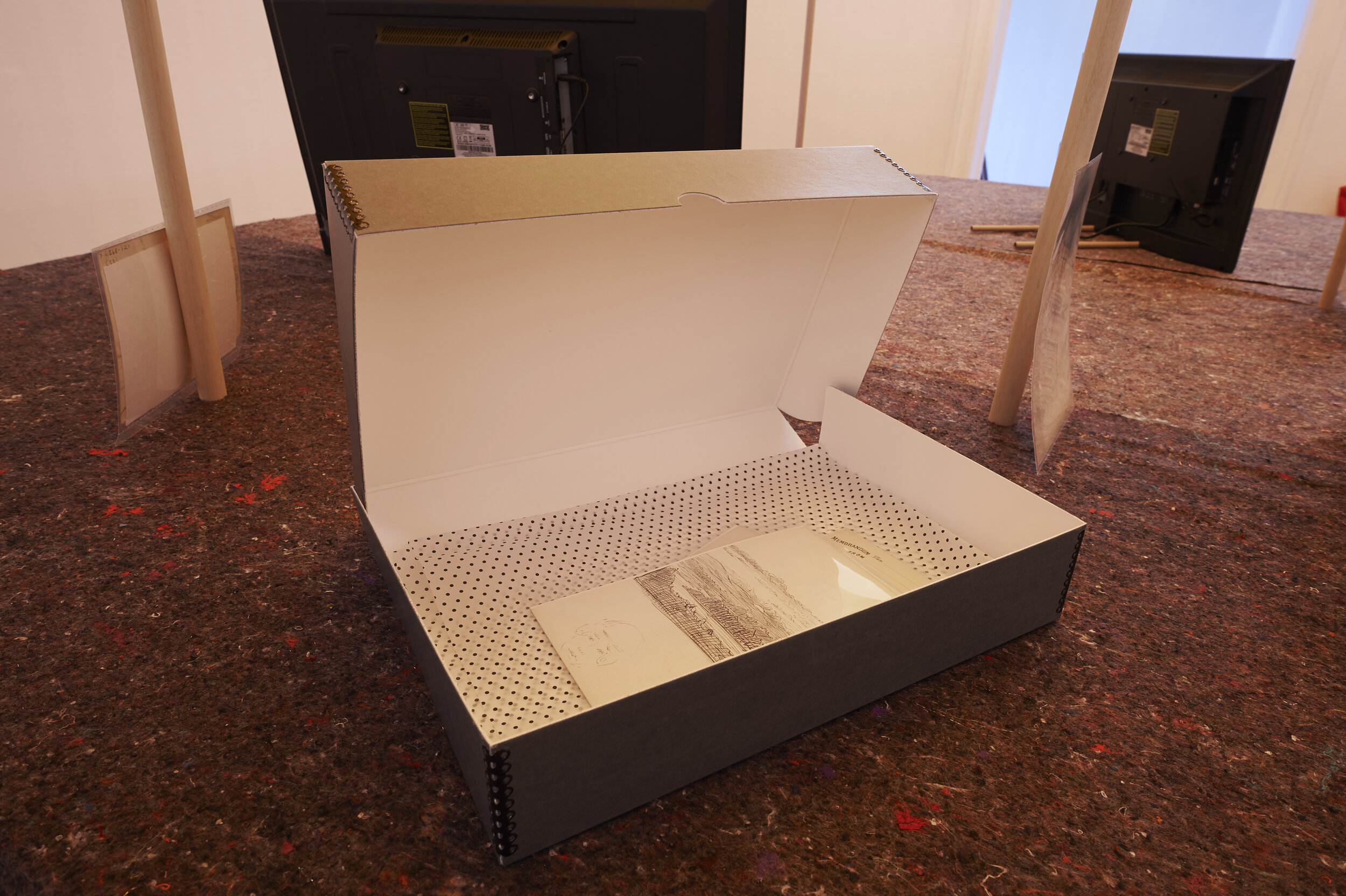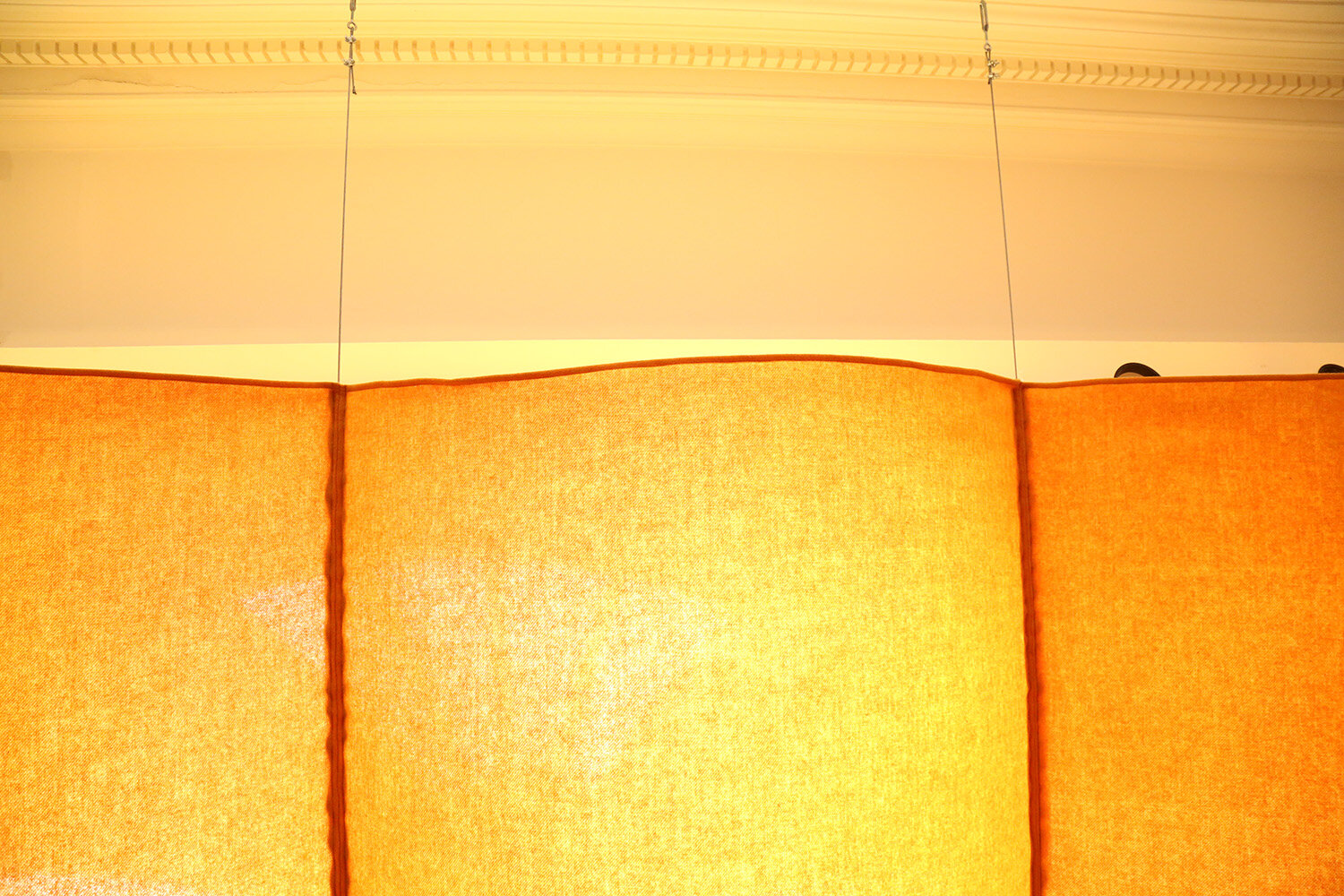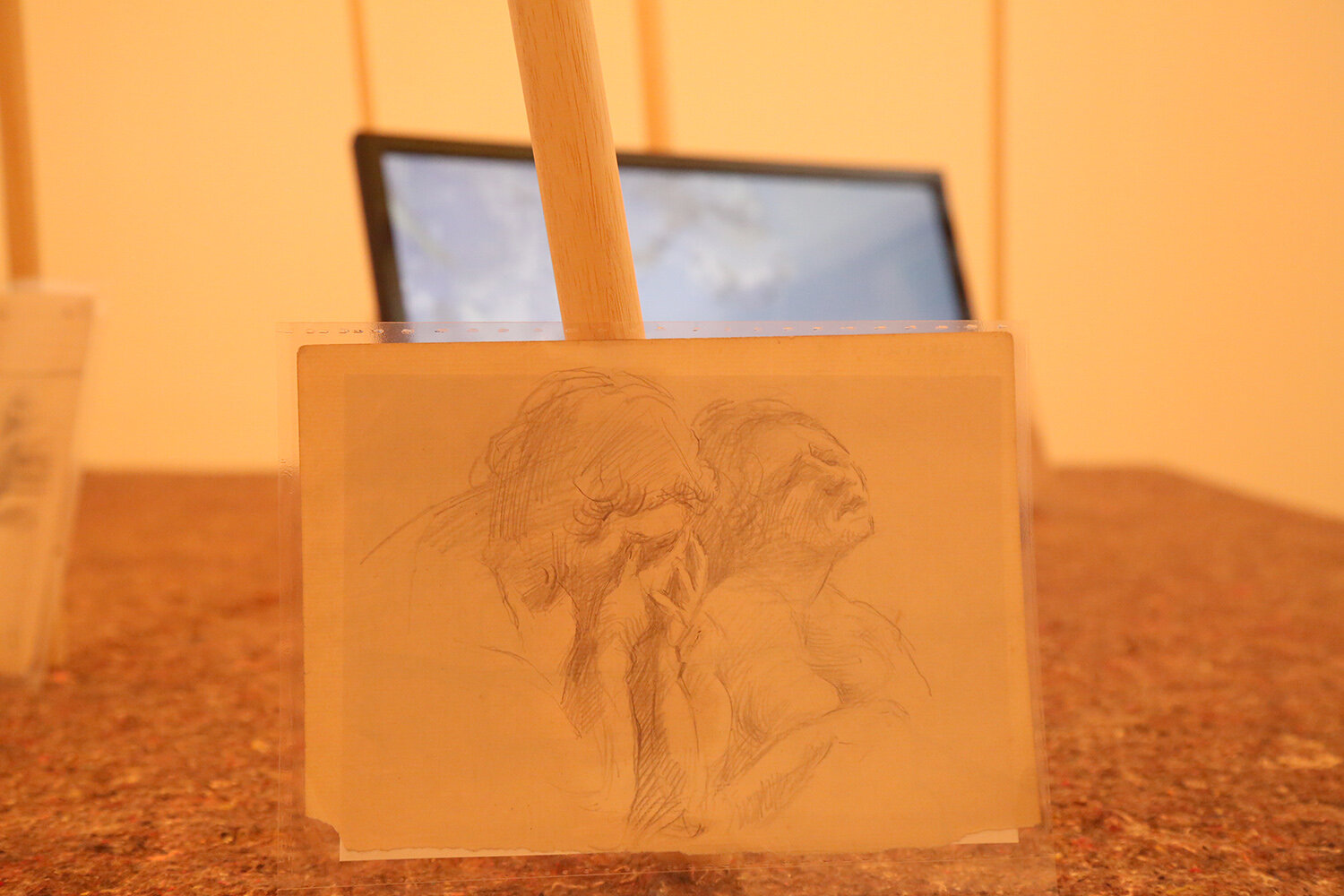The Yellowing, Part 1
Solo exhibition, commissioned by fig-futures and presented at The Grundy Art Gallery, UK (2018)
I'm in a forest, just outside Oslo, where I live. I'm sitting directly on the forest floor. This is a performance, for you. Usually, I would be in the room with you, but I wanted to be in the forest for this one.
You are in Blackpool, and I am in the forest in Norway.
I've left you some things to look at, I'll talk you through them.
The Yellowing, part 1 was a site-specific installation that invited the viewer to the telling of a story about material, environmental and social surfaces- paper, textile, and rock; a roadside outside of Blackpool, Norwegian forest floors, the fields of the Fylde; a kitchen table, a shared song and a knitting circle. The work investigated the politics of the surface: how we order, protect and privilege some surfaces over others, so as to obscure the instability that frequently lies beneath.
‘The Yellowing, part 1 illustrates Birch’s on-going practice of gathering histories and narratives in every new location she engages with. For fig-futures, the artist has produced a multi-layered, interactive installation that gives a platform, both physically and metaphorically, to a range of voices whose stories cross time and place.’ Paulette Brien, Curator, Grundy Art Gallery
For this project, my own video work was brought into dialogue with a range of natural and archival objects including a selection of original drawings by Patti Mayor from the Grundy’s Collection, and an ‘anti-fracking yellow’ Harris Tweed sail made specifically for the Rotunda Gallery ceiling, and a packing blanket. A large table-top concealed the central void between the Grundy’s foyer and 1st floor gallery. On this table, guided by the audio narration, and supported by the host present in the space, the audience was invited to take part in the unfolding of the installation.
The work was commissioned by fig-futures, supported by Outset, Arts Council England and Art Fund. The work is now held in the Grundy Art Gallery Collection.
Please scroll down for an image and text version of the work. You can watch / listen to my interview about the project with Yves Blais, Outset, on the fig-futures webpage.
Open the larger box and take out the first drawing. It's a tree from near here, from just outside Kirkham.
Prop it up against one of the sticks, making the drawing of the tree stand up.
So this forest floor that I'm sitting on, the O of the soil horizon, contains indistinct organic material, pine needles, pine cones, moss, small twigs and larger branches, bits of bark, blueberry bush shoots coming up, lichens knitted together on branches, rocks and soil. All of it in various states of decomposition, of collapsing from discrete thing into surface.
Have a closer look at these branches. You can see how the lichens create a kind of outer layer, a second surface around the bark. A replication of the form of the branch, but with sprouts and other branches of their own, you can see the hairy, larger clumps, this is a kind of evernia, quite possibly evernia vulpina, which when boiled dyes wool a warm rich shade of yellow, that can be used to weave tweed.
I picked these branches up a few weeks ago, during the spring snow melt. The forest floor had been white for the whole winter, ever since I arrived in Oslo, but finally began to melt in late April. What surprised me, having not seen it before, is that it melted from beneath, so the as the earth below warmed, the lowest layer of snow melted. So as I walked through the forest, I would step on what looked like a solid layer of compressed ice and snow, but then suddenly my foot punctured it, and there was water running underneath. And sometimes a whole piece of ice shifted downwards because something had been carved out underneath it. Which was really disconcerting.
Now take out the next drawing.
This is Patti Mayor, an artist who lived and worked in this area, she knew it really well.
The condition report stored in the archive with this drawing says 'yellowing'.
So take out the next drawing, this you can see is a landscape, a local landscape, the Fylde.
Back, here, in Oslo, the forest floor is dense and complex, and in the Fylde, whllst more widely cultivated, there are similar moments of complexity, Mayor studied the ground and turned it into cross-hatches and other marks. A kind of form of drawn gardening. Another local woman, digging on her allotment, just outside St Annes, told me that it feels good to break the ground at the beginning of each growing season. That it is a compelling, almost addictive act. Once she starts turning the ground over, she can't stop.
What interests me about Patti Mayor, is that it seems from her sketchbooks that she was more interested in the surface of social interaction, in the communications between us, particularly between women.
There are a lot of drawings that show groups of women, sitting in living room spaces, playing instruments, talking, spending time together.
Reminds me of a living room in Scotland, in Greenock, where I did quite a lot of filming with a group of women who waulk tweed.
The process of waulking tweed is to mat it, you wet it, you slap it around rhythmically, and through doing that you turn the lose woven cloth into a solid fabric surface, which will protect the wearer from the elements, so it would be waulked for different amounts, depending on its function; if it was fisherman's trousers, you would waulk it as tightly as you could.
They are sitting around a dining room table, and they are waulking the tweed together, they do it every Monday night, practising for performances that they do around the region, but these Monday night meetings are what's really crucial, because they don't only waulk the tweed, they share a lot of other emotional and personal experiences, and the table is the place where it all occurs.
The local woman with the allotment, that you are watching, there on the screen, when I visited her at her home, and I wanted to interview her, to film her, wanted to restore the table to its status as semi-decorative surface before we did the filming. She made a very specific arrangement of mat, plate and two crystal bowls. Placing the last bowl, she stated firmly, 'it goes here'.
My nine month old daughter recently discovered that the yellow kitchen table that we eat our meals at has an underneath. She spent a whole breakfast time pushing her hand as far as she could into this newly discovered void, and banging the tabletop from beneath.
Earlier this year, in January, I was at another kitchen table, in a house just off the road out of Blackpool towards Kirkham.
The woman whose home that is, whose kitchen table it is, was very apologetic as we sat down to talk. She started clearing things off the surface, this she said, is the everything table, the eating table, the working table, the place where things arrive and rest when they enter the house, and where some items take up semi-permanent residence, so she has to do a clear off every so often.
She has three children, and feels very strongly the connection between the earth and future. She realised that she should go there.
The table collects things that are passing, it has things in action, things no longer needed. It becomes quite chaotic as things pile up, and it can be hard to find a firm, stable spot to put, for example, a cup of tea down. At a certain point, things start collapsing into each other, and sliding off the side of, the table. That moment often takes her by surprise.
But very soon she's going to be tidying this table into boxes because they are moving, leaving entirely from here, she cannot take the ongoing anxiety of the situation.
So the table will get put into a van, protected by a packing blanket. The packing blankets, like those in front of you, are non woven, there is no knitting or weaving involved in creating them, they will not last nearly as long as the tweed. They are loose conglomerations of threads and fibres, a bit like the forest floor, I suppose.
Of course, if one came to really, intimately know the land beneath the snow, or the land beneath the road, one could maybe begin to predict where the water would be flowing, but that needs an intimacy with the very local topography that might take years, the kind of intimacy that enabled a local dairy farmer here in Lancashire to draw, through his hand gestures the subterranean water courses that flow under his fields.
You could take out the next drawing now.
He knows where the aquifers run down to the Ribble. When he looks at his field he not only sees the grass above, but he sees this invisible structure beneath. He described to me how the whole area was once much more waterlogged, and how occasionally, when they are ploughing the fields, they pull entire tree trunks out, that had been there suspended in the marshy earth. As as they pull a tree trunk out, the land surface sinks a little as it settles into the hole.
I've been walking in this forest for 6 months now. I don't often take the track that goes to the right, because I realised that it goes nowhere, it ends a few metres around the corner, at huge doors leading directly into the rock of the hillside. And I've noticed another pair of doors, on the other side, I assume that they must connect underneath. I asked another woman, last autumn, if she knew what the doors were. She was on her hands and knees in the moss, she was hunting for, and cataloguing, inedible fungi on the forest floor. It was very late autumn, just as the first snow was falling. She told me she's not really sure, she thinks that it is the military, but she knew no more than that. For her, that seemed enough of an explanation.
Sometimes, walking in the forest I hear strange rumblings, distant planes, boats, or something else.
Supported by: Outset, Arts Council England. Purchase of the work by The Grundy Art Gallery supported by The Art Fund. The Yellowing, part 1 was developed through the research and filming of Undermine, which was additonally supported by Arts Council England, Lancaster Arts and Film London Artists’ Moving Image (FLAMIN)
Huge thanks to Miranda Cox, Bobby Black, Janette Allison, Carole Wilson, Tina Rothery, Julie Daniels, Kitty Bouman and all others at Preston New Road


















